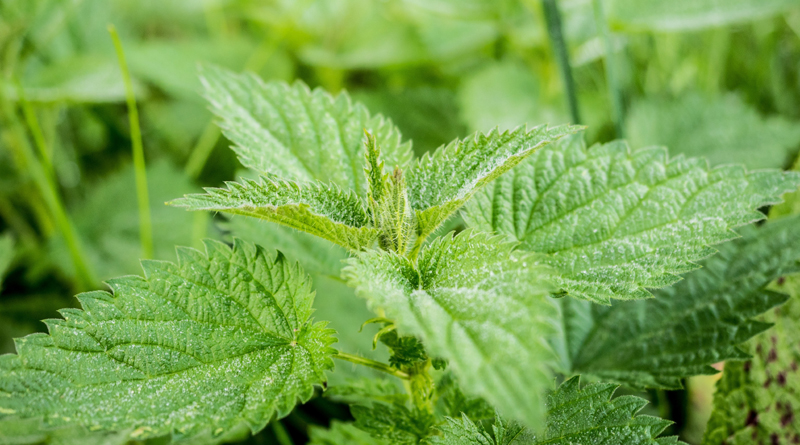STOP WEEDING! 8 GARDEN WEEDS THAT ARE GOOD FOR YOUR HEALTH
When you think of superfoods you probably think of acai berries, chia seeds, or some other exotic plant. Yet, you may be surprised to discover that a wide range of plants common to the UK can provide a whole host of health benefits. You may even find a fair few growing as weeds in your garden.
So, before you throw all that nutritional goodness in the compost bin, check this list to find out if they could be put to better use in your kitchen.
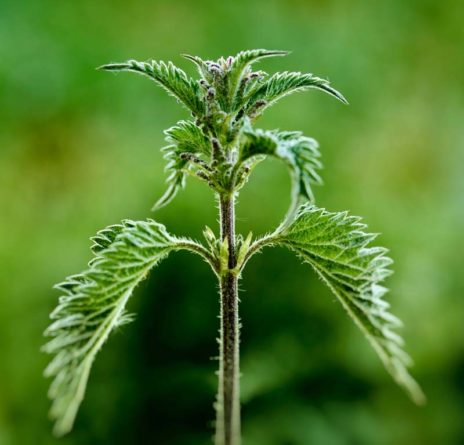 Nettle (Urtica dioica)
Nettle (Urtica dioica)
The stinging nettle grows pretty rampantly throughout the UK. But did you know that it contains about as much Omega-3 as spinach, essential amino acid levels comparable to chicken, and a whole host of vitamins, including: 100% of your recommended daily intake (RDI) of Vitamin A, up to 50% of Calcium, 20% of Fibre and up to 12% of Iron (1).
To prepare nettles to eat, simply drop them in a pot of boiling salted water for a few minutes to render the sting harmless. Alternatively, you can dry them (using a dehydrator if you have one) or soak them in water for a few days. You can then use them in a variety of recipes, such as nettle pesto or soup, or as an infusion in tea. Alternatively, pick up a can of Emunity ─ a new healthy soft drink that harnesses the healing and immunity-boosting effects of nettle.
Chamomile (Matricaria recutita L.)
One of the most popular ingredients in herbal teas is chamomile. While its benefits to a good night sleep have been widely reported, there is strong scientific evidence to suggest that this common flower has a range of other health benefits.
The chemicals found in chamomile flowers have been shown to be moderate antioxidants and antimicrobials. What’s more, animal model studies indicate potent anti-inflammatory action and some cholesterol-lowering activities (4).
Chamomile flowers can be washed, dried and used on their own, or as a blend, in herbal teas. It also serves as an attractive and healthy garnish to desserts, such as panna cotta.
Be careful if you are allergic to flowers like daisies, however, as chamomile can cause allergic reactions.
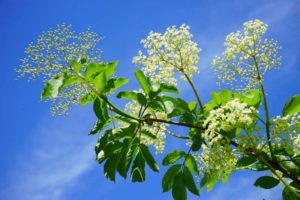
Elderflowers (Sambucus nigra L.)
Another popular and refreshing summer drink is elderflower ─ often in the form of cordial. The earliest records of elderflower cordial date back as far as Roman times!
You can often find fresh elderflower throughout the British countryside and sometimes in your back garden. Fresh elderflowers also contain a lot more goodness than their dried counterparts, so making it yourself can be one of the best ways to extract the full health benefits of these flowers.
Elderflowers are a rich source of bioactive compounds, such as polyphenols, which bring a number of health benefits such as anti-pyretic (helping reduce fever), diuretic, antibacterial and anti-inflammatory (5).
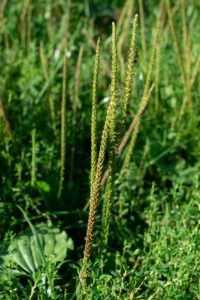 Broadleaf Plantain (Plantago Major)
Broadleaf Plantain (Plantago Major)
When you think of plantain you probably think of the green banana relative found in African and East Asian cuisine. The broadleaf plantain, however, is a completely different plant commonly found across Europe.
Often found by roadsides as a leafy weed, the broadleaf plantain has a wide variety of health benefits that have been used as far back as 1000 years ago. More recent studies have shown that broadleaf plantain can be useful for enhancing the immune system, reducing the size of tumours, and protecting the gut (6).
It is also an anti-inflammatory, anti-infective, antibiotic, antifungal, antiviral and antioxidant (6), and they are also high in calcium and vitamins A, C, and K (7). It can also be used to heal the skin when applied locally.
Both leaves and the seeds of the broadleaf plantain can be eaten raw or cooked in stew or simply baked on their own.
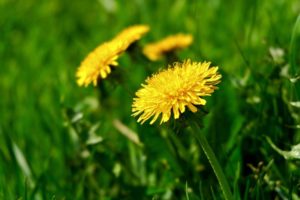 Dandelion (Taraxacum officinale L.)
Dandelion (Taraxacum officinale L.)
One plant we have all found growing in our garden at one point or another is the dandelion. And while we may have enjoyed a glass of dandelion and burdock at some point, we may not have considered the health benefits of this incredible plant.
Dandelion has long been used in folk medicine as a cure for sore throats, high blood pressure and urinary infections. Recent research has substantiated a number of these health benefits, showing that dandelion can indeed reduce cholesterol, blood glucose levels (2), and inflammation (3). As a mild diuretic, it can also help if you are suffering from a UTI (urinary tract infection) or thrush.
All of the dandelion plant can be used in various recipes, from petal-infused wine or honey to simply eating dandelion roots whole, just like carrots or parsnips. You can even enjoy the benefits of dandelion in Emunity’s Gooseberry drink, which contains nettle, gooseberry, dandelion, rosemary and thyme.
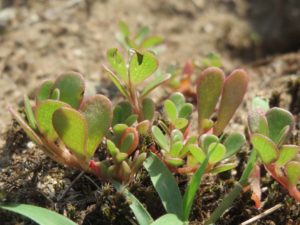 Common Purslane (Portulaca Oleracea)
Common Purslane (Portulaca Oleracea)
Common purslane is found in gardens and public spaces across the UK and is often seen as a weed, given its hardiness and ability to rapidly spread. The succulent leaves of the common purslane are also an excellent source of nutrients and antioxidants!
It is incredibly rich in potassium (494 mg/100 g), magnesium (68 mg/100 g) and calcium (65 mg/100 g) and it contains four different types (8) of omega-3 fatty acid (9) ─ useful for controlling cholesterol.
Also helping its cholesterol-busting properties, common purslane has some of the highest amounts of alpha-linolenic acid (ALA) and gamma-linolenic acid (LNA) of any green leafy vegetable (8).
The leaves of purslane can be washed and eaten raw in a salad, mixed into delicious chimichurri sauce or blended with basil and pine nuts into a healthy twist on pesto. In fact, there are lots of things you can do with purslane for an extra healthy kick to your food!
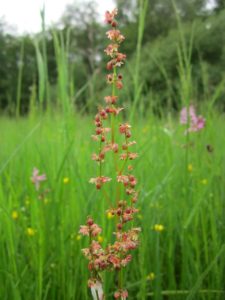 Sheep Sorrel (Rumex Acetosella)
Sheep Sorrel (Rumex Acetosella)
Another perennial weed native to the UK is wild sheep sorrel. It is a small flowering plant that is commonly found growing in back gardens across the country.
As a good source of vitamins C and E, it can contribute to a healthy immune system and glowing skin. Sheep sorrel is also a very good source of antioxidants (10). However, due to its high levels of potassium oxalate, it should only be eaten in small amounts.
Sheep sorrel has a tart, almost lemony flavour that can be a wonderful addition to salads or mixed into a stir fry for a healthy boost. It is best harvested in summer or early autumn.
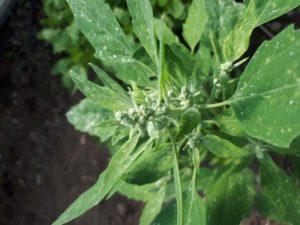 Lambsquarters (Chenopodium album)
Lambsquarters (Chenopodium album)
Otherwise known as white goosefoot, this fast-growing plant is often seen as a weed and is commonly found in gardens and the countryside across the UK. Despite being seen as a weed, however, it is incredibly rich in folate (11). In fact, raw lambsquarters has the highest amount of folate (97.5 μg/100 g) of any commonly found weed.
It is also rich in carotenoids (commonly associated with carrots) which can be converted into vitamin A which is essential for growth, immune system function, and eye health.
Lambsquarters also contains over 10% of your RDI of iron and magnesium, as well as both vitamins B6 (when steamed) and K (11).
Once harvested, wash your lambsquarters to get rid of the white powdery bloom and other debris. It can then be eaten raw in salads or, for maximum extraction of vitamin goodness, steamed or sauteed and added to almost any recipe you might use spinach in. You could try it in a quiche, with fried eggs for breakfast, or roasted on their own with some fresh garlic.
As you can see, your back garden can be an excellent source of nutritious vegetation that can be easily added or substituted into your recipes to give meals an extra healthy boost. So before you start throwing these common weeds into your compost bin, try washing them off and adding them to your food.
ABOUT THE AUTHOR
Roy Lamb is a pharmacist and co-founder of UK-based Nasslor Health-drinks Ltd., makers of Emunity. Emunity is the first detox health drink to harness the healing and immunity-boosting benefits of Nettle and make it available in a ready-to-drink can. Emunity’s founders are two UK pharmacists with a passion for helping people stay healthy. Taking an old family recipe they have blended nettles with English Garden Herbs to create a great tasting, refreshing drink loaded with immune boosting health benefits. It is 100% natural, with no artificial Ingredients and only 53 calories per can.
Website and shop: emunity.co.uk
Twitter: twitter.com/emunitydrinks
Instagram: @emunitydrinks
Facebook: ‘Emunity Drinks’ – facebook.com/Emunity-Drinks-101222345096132/
References:
- Mineral Properties and Dietary Value of Raw and Processed Stinging Nettle (Urtica dioica L.); Laban K. Rutto, Yixiang Xu, Elizabeth Ramirez, and Michael Brandt; International Journal of Food Science; 2013, Article ID 857120
- Pro-health activity of dandelion (Taraxacum officinale L.) and its food products – history and present; Bernadetta Lis & Beata Olas, Department of General Biochemistry, Faculty of Biology and Environmental Protection, University of Lodz, Lodz, Poland
- Antioxidants in Vegetables and Nuts – Properties and Health Benefits. Kour J. et al. (2020) Dandelion. In: Nayik G.A., Gull A. (eds) Springer, Singapore.
- A Review of the bioactivity and potential health benefits of chamomile tea (Matricaria recutita L.); Diane L. McKay & Jeffrey B. Blumberg, Phytotherapy Research, Volume 20, Issue7, July 2006, Pages 519-530
- Bioactive properties of elderflowers (Sambucus nigra L.), Dorota Walkowiak-Tomczak, World Scientific News, 2017, 73 (2) pages 115-119
- Najafian Y, Hamedi SS, Farshchi MK, Feyzabadi Z. Plantago major in Traditional Persian Medicine and modern phytotherapy: a narrative review. Electron Physician. 2018;10(2):6390-6399. Published 2018 Feb 25. doi:10.19082/6390
- https://plants.ces.ncsu.edu/plants/plantago-major/
- Multipurpose Benefits of an Underexplored Species Purslane (Portulaca oleracea L.): A Critical Review. Srivastava, R., Srivastava, V. & Singh, A., Environmental Management (2021)
- Purslane Weed (Portulaca oleracea): A Prospective Plant Source of Nutrition, Omega-3 Fatty Acid, and Antioxidant Attributes”, Md. Kamal Uddin, Abdul Shukor Juraimi, Md Sabir Hossain, Most. Altaf Un Nahar, Md. Eaqub Ali, M. M. Rahman, The Scientific World Journal, vol. 2014, Article ID 951019, 6 pages, 2014.
- Total phenolic content, antiradical and antioxidant activities of wild and cultivated Rumex acetosella L. extracts, Sebnem Selen Isbilir & Ayten Sagiroglu, Biological Agriculture & Horticulture, (2013) 29:4, 219-226
- Nutrient composition of selected traditional United States Northern Plains Native American plant foods, K. Phillips, P. Pehrsson, W. Agnew, A. Scheett, J. Follett, H. Lukaski, K. Patterson, Journal of Food Composition and Analysis, Volume 34, Issue 2, 2014, Pages 136-152

